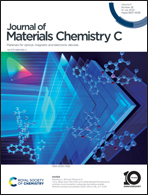Molecular design of phenazine-5,10-diyl-dibenzonitriles and the impact on their thermally activated delayed fluorescence properties†
Abstract
The photoluminescence properties of the compounds 3,3′-(phenazine-5,10-diyl)dibenzonitrile (mBN) and 4′,4′′′-(phenazine-5,10-diyl)bis(([1,1′-biphenyl]-4-carbonitrile)) (BPN) are presented and compared to those of the known fluorophore 4,4′-(phenazine-5,10-diyl)dibenzonitrile (pBN), which has been reported to show thermally activated delayed fluorescence (TADF). In the solid state, pBN shows clear TADF properties. In contrast, TADF is only weakly pronounced in mBN, and BPN is a conventional fluorescent emitter. This is discussed in terms of the provided through-space overlap between donating phenazinediyl and accepting benzonitrile units in these three molecules, which is only effective in pBN. These compounds are only weakly luminescent in toluene, tetrahydrofuran (THF) or dichloromethane (CH2Cl2) solution, most intensively in toluene, with yellow (pBN and mBN) to orange (BPN) colors of the emission. The emission maxima λem,max in toluene differ slightly between pBN (562 nm) and mBN (572 nm) and overlap in THF (634 nm) and CH2Cl2 (∼660 nm), respectively. Their emission is broad-banded and strongly solvent-dependent and thus indicates a CT-type nature of the excited state. BPN shows weak solvent-dependent photoluminescence (604 nm in toluene, 589 nm in THF, and 587 nm in CH2Cl2) and together with an observable vibronic structure in the low temperature spectra of the powder, it can be concluded that emission in BPN occurs from a localized electronic (LE) state non-beneficial for TADF properties. This demonstrates that even tiny modifications in the molecular templating structure of the phenazines can significantly affect their TADF properties.



 Please wait while we load your content...
Please wait while we load your content...